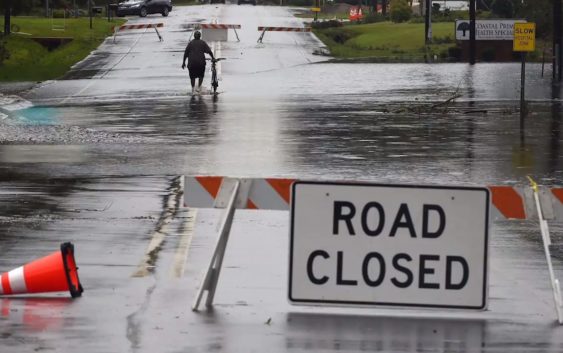- Heavy rain floods downtown Whiteville forcing local businesses to deal with damage again
- New legislative panels will investigate “facts and circumstances” of deadly Central Texas floods
- Springfield Middle School fully reopens next week, a year after devastating EF3 tornado
- Dozens rescued as remnants of typhoon hits Alaska while nor’easter brings flooding to East Coast
- New Jersey declares emergency as nor’easter approaches, while Alaska flooding carries away homes
Florence complicates the NC election process. Will it keep people from voting?

Turnout may be tempered in the upcoming election after Hurricane Florence impaired North Carolina’s infrastructure, displaced thousands of voters and distracted from political issues as candidates jockey for favor.
The deadly storm arrived just as door-knocking, campaign advertisements and fundraising started to ramp up.
At stake this year are a state Supreme Court seat, congressional seats, six proposed constitutional amendments and control of North Carolina’s legislature, along with municipal races. Republicans control the legislature, and Democrats hope to gain influence by winning four House seats or six Senate seats to break the GOP supermajority.
But Florence has thrown a wrench into the Republican and Democratic machines. It dumped record amounts of rain from the coast to the Piedmont, causing flooding that’s displaced countless residents and complicated the election preparation process.
More than 10,000 people were living in shelters as of Tuesday, Gov. Roy Cooper said in a press conference.
It’s unclear how long people will be prevented from returning home and whether damage from the storm will affect voting locations. Election Day is Nov. 6, early voting starts Oct. 17 and absentee ballots became available earlier this month.
An immediate effect of Florence is that several county elections boards are bogged down and can’t mail them out. Damage from Florence on Tuesday left 227 zip codes — mostly in southeastern North Carolina — without service Tuesday, according to an analysis of U.S. Postal Service disruptions by Bill Busa, a data scientist who founded NCgovote.org.
So the N.C. Board of Elections and Ethics Enforcement announced Monday it is “stepping in to send out ballots for several counties that are unable to do so because their operations are affected by flooding, power and internet outages or inaccessible due to the storm.”
Nonprofit organizations plan to help. Democracy NC may send voting advocates across the state to affected areas to see what voters need help with, said Jen Jones, the group’s communications director.
“We have a little more time than we did when (Hurricane) Matthew came” in October 2016, Jones said in a phone interview. “We can possibly make up for what was lost in those counties.”
The North Carolina NAACP also plans to help distribute absentee ballot applications to registered voters in areas affected by Florence, according to a Monday email announcement.
“It is imperative that while our communities struggle to recover from the devastating flooding and other destruction from this storm, citizen’s right to vote should not be impaired,” the Rev. T. Anthony Spearman said in a statement. “The NAACP has long advocated for the right to vote and we know from the experience of Hurricane Matthew in 2016 that flood-impacted areas had depressed voter turnout.”
Voting absentee
Anyone can vote absentee for any reason. The state elections board website has a page at ncsbe.gov/absentee-voting-mail dedicated to explaining the process for voting absentee by mail.
As of Tuesday afternoon, 14,473 people had requested absentee ballots and 8,653 had been sent out, according to the elections board. About 126 have been returned and 117 have been counted by the board.
How soon others are returned might depend on how quickly the Postal Service can reopen its offices — and older voters are likely to be most affected, Busa said.
“How rapidly postal service comes back online is going to be an important determinant” for absentee votes, he said. “A large fraction of voters aged 70 and above vote absentee by mail.”
Turnout after Matthew
Hurricane Matthew was a Category 1 storm when it hit North Carolina in early October 2016, flooding multiple coastal counties.
Cumberland, Edgecombe, Robeson and Wayne counties were the first to receive federal housing funds to help recover from Hurricane Matthew. In three of those counties, participation was down in the 2016 election compared to the prior presidential election in 2012. Turnout rose in Cumberland from 59.8 percent in 2012 to 60.4 percent in 2016.
In Edgecombe, it was 68.1 percent in 2012 and 64.6 percent in 2016. In Robeson, turnout was 57.7 percent in 2012 and 54.2 percent in 2016. In Wayne, it was 68.9 percent in 2012 and 66.8 percent in 2016.
Many factors play into voter turnout, from the weather to the appeal of top-of-the-ballot candidates. So it’s unclear exactly how much Matthew affected turnout. But Busa found that participation among black voters in hurricane-affected counties was about 12 percent lower than other counties.
Campaigning ceasefire
The political parties say they’re focused on helping with recovery.
“North Carolina Democrats are focused on helping our state recover, and with many communities still facing historic flooding and damage and rivers still rising, it’s too early to be concerned with politics,” said Robert Howard, spokesman for the NC Democratic Party. “We hope people stay safe, listen to emergency officials, and spend time with their families and loved ones as the state continues to recover.”
Dallas Woodhouse, executive director of the NC Republican Party, struck a similar tone.
“For now we have suspended sending direct mail to many areas, and we have pulled all our field people out of eastern North Carolina for the time being,” Woodhouse said in an email.
“This is just not the time for politics in many areas across the state,” Woodhouse said. “Our legislative incumbents in hard hit areas, are focused on helping communities recover and will not be campaigning much for the foreseeable future.”